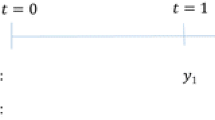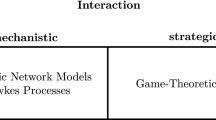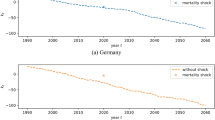Abstract
In this paper, we design a competition framework for two insurers with ambiguity aversion under the utility framework and investigate the resulting stochastic reinsurance game problem. Each insurer does not have perfect confidence in the drift terms of the insurance risk and chooses to purchase per-loss reinsurance to reduce her claim risk, and the reinsurance premium is determined via the mean-variance premium principle. The objective of each insurer is to find the optimal reinsurance strategy so as to maximize the ratio of expected utility of her terminal payoff to her competitor’s under the worst-case scenario. By the dynamic programming principle and corresponding Hamilton–Jacobi–Bellman–Isaacs equation, we derive the solutions for both the equilibrium reinsurance strategy and value function under the exponential utility function. In particular, we examine the existence and uniqueness of equilibrium strategy. Finally, several numerical examples are presented to illustrate the effects of competitive relationship, ambiguity aversion and some important model parameters on the equilibrium strategy, which provide useful insights for reinsurance in reality.








Similar content being viewed by others
Notes
In some insurance optimization problems, researchers impose the condition that retained and transferred claims are non-decreasing functions of the underlying claim. However, in this paper, we can obtain the same monotonicity of \({\mathcal {H}}_i(t,Z_i)\) and \(Z_i- {\mathcal {H}}_i(t,Z_i)\) without requiring that condition a priori.
\(a\wedge b\) denotes the \(\min \{a, b\}\) and \(a\vee b\) means the \(\max \{a, b\}\).
References
Anderson, E. W., Hansen, L. P., & Sargent, T. J. (2003). A quartet of semigroups for model specification, robustness, prices of risk, and model detection. Journal of the European Economic Association, 1(1), 68–123.
Bai, L., Cai, J., & Zhou, M. (2013). Optimal reinsurance policies for an insurer with a bivariate reserve risk process in a dynamic setting. Insurance: Mathematics and Economics, 53, 664–670.
Bai, L., Guo, J., & Zhang, H. (2010). Optimal excess-of-loss reinsurance and dividend payments with both transaction costs and taxes. Quantitative Finance, 10(10), 1163–1172.
Bai, Y., Zhou, Z., Xiao, H., Gao, R., & Zhong, F. (2022). A hybrid stochastic differential reinsurance and investment game with bounded memory. European Journal of Operational Research, 296(2), 717–737.
Baltas, I., Dopierala, L., Kolodziejczyk, K., Szczepański, M., Weber, G. W., & Yannacopoulos, A. N. (2022). Optimal management of defined contribution pension funds under the effect of inflation, mortality and uncertainty. European Journal of Operational Research, 298(3), 1162–1174.
Basak, S., & Makarov, D. (2014). Strategic asset allocation in money management. The Journal of finance, 69(1), 179–217.
Bensoussan, A., Siu, C. C., Yam, S. C. P., & Yang, H. (2014). A class of non-zero-sum stochastic differential investment and reinsurance games. Automatica, 50(8), 2025–2037.
Bi, J., Cai, J., & Zeng, Y. (2021). Equilibrium reinsurance-investment strategies with partial information and common shock dependence. Annals of Operations Research, 307, 1–24.
Borch, K. (1960). Reciprocal reinsurance treaties. ASTIN Bulletin, 1, 171–191.
Brachetta, M., & Ceci, C. (2020). A BSDE-based approach for the optimal reinsurance problem under partial information. Insurance: Mathematics and Economics, 95, 1–16.
Chen, L., Qian, L., Shen, Y., & Wang, W. (2016). Constrained investment-reinsurance optimization with regime switching under variance premium principle. Insurance: Mathematics and Economics, 71, 253–267.
Chen, Z., & Yang, P. (2020). Robust optimal reinsurance-investment strategy with price jumps and correlated claims. Insurance: Mathematics and Economics, 92, 27–46.
Galindo, H., Gallardo, J. M., & Jiménez-Losada, A. (2021). A real Shapley value for cooperative games with fuzzy characteristic function. Fuzzy Sets and Systems, 409, 1–14.
Gallardo, J. M., & Jiménez-Losada, A. (2020). A characterization of the Shapley value for cooperative games with fuzzy characteristic function. Fuzzy Sets and Systems, 398, 98–111.
Grandell, J. (1991). Aspects of risk theory. New York: Springer.
Guan, G., & Liang, Z. (2019). Robust optimal reinsurance and investment strategies for an AAI with multiple risks. Insurance: Mathematics and Economics, 89, 63–78.
Han, X., Liang, Z., & Young, V. R. (2020). Optimal reinsurance strategy to minimize the probability of drawdown under a mean-variance premium principle. Scandinavian Actuarial Journal, 2, 1–25.
Han, X., Liang, Z., Yuen, K. C., & Yuan, Y. (2021). Minimizing the probability of absolute ruin under ambiguity aversion. Applied Mathematics and Optimization, 84(3), 2495–2525.
Hata, H., & Sheu, S. J. (2017). An optimal consumption and investment problem with partial information. Advances in Applied probability, 50(1), 131–153.
Huang, Y., Yao, O., Tang, L., & Zhou, J. (2018). Robust optimal investment and reinsurance problem for the product of the insurer’s and the reinsurer’s utilities. Journal of Computational and Applied Mathematics, 344(5), 532–552.
Jeanblanc, M., Mastrolia, T., Possamai, D., & Reveillac, A. (2015). Utility maximization with random horizon: A BSDE approach. International Journal of Theoretical and Applied Finance, 18(7), 1550045.
Kalayci, B., Özmen, A., & Weber, G. W. (2020). Mutual relevance of investor sentiment and finance by modeling coupled stochastic systems with MARS. Annals of Operations Research, 295, 183–206.
Kara, G., Özmen, A., & Weber, G. W. (2019). Stability advances in robust portfolio optimization under parallelepiped uncertainty. Central European Journal of Operations Research, 27, 241–261.
Kropat, E., Weber, G. W., & Tirkolaee, E. B. (2020). Foundations of semialgebraic gene-environment networks. Journal of Dynamics and Games, 7(4), 253–268.
Li, D., Rong, X., & Zhao, H. (2014). Optimal reinsurance-investment problem for maximizing the product of the insurer’s and the reinsurer’s utilities under a CEV model. Journal of Computational and Applied Mathematics, 255, 671–683.
Li, D., Zeng, Y., & Yang, H. (2018). Robust optimal excess-of-loss reinsurance and investment strategy for an insurer in a model with jumps. Scandinavian Actuarial Journal, 2, 145–171.
Luo, S., Wang, M., & Zhu, W. (2019). Maximizing a robust goal-reaching probability with penalization on ambiguity. Journal of Computational and Applied Mathematics, 348, 261–281.
Morlais, M. A. (2009). Utility maximization in a jump market model. Stochastics, 81(1), 1–27.
Palanci, O., Alparslan Gök, S. Z., & Weber, G. W. (2014). Cooperative games under bubbly uncertainty. Mathematical Methods of Operations Research, 80, 129–137.
Promislow, S. D., & Young, V. (2005). Minimizing the probability of ruin when claims follow Brownian motion with drift. North American Actuarial Journal, 9(3), 110–128.
Pun, C. S., Siu, C. C., & Wong, H. Y. (2016). Non-zero-sum reinsurance games subject to ambiguous correlations. Operations Research Letters, 44(5), 578–586.
Savku, E., & Weber, G. W. (2022). Stochastic differential games for optimal investment problems in a Markov regime-switching jump-diffusion market. Annals of Operations Research, 312(2), 1171–1196.
Siu, C. C., Yam, S. C. P., Yang, H., & Zhao, H. (2017). A class of nonzero-sum investment and reinsurance games subject to systematic risks. Scandinavian Actuarial Journal, 8, 670–707.
Yan, M., Peng, F., & Zhang, S. (2017). A reinsurance and investment game between two insurance companies with the different opinions about some extra information. Insurance: Mathematics and Economics, 75, 58–70.
Yang, H., & Zhang, L. (2005). Optimal investment for insurer with jump-diffusion risk process. Insurance: Mathematics and Economics, 37(3), 615–634.
Yang, P., Chen, Z., & Xu, Y. (2020). Time-consistent equilibrium reinsurance-investment strategy for n competitive insurers under a new interaction mechanism and a general investment framework. Journal of Computational and Applied Mathematics, 374, 112769.
Yuan, Y., Han, X., Liang, Z., & Yuen, K. C. (2023). Optimal reinsurance-investment strategy with thinning dependence and delay factors under mean-variance framework. European Journal of Operational Research, 311, 581–595.
Yuan, Y., Liang, Z., & Han, X. (2022). Robust reinsurance contract with asymmetric information in a stochastic Stackelberg differential game. Scandinavian Actuarial Journal, 4, 328–355.
Yuan, Y., Liang, Z., & Han, X. (2023). Robust optimal reinsurance in minimizing the penalized expected time to reach a goal. Journal of Computational and Applied Mathematics, 420, 114816.
Yuen, K. C., Liang, Z., & Zhou, M. (2015). Optimal proportional reinsurance with common shock dependence. Insurance: Mathematics and Economics, 64, 1–13.
Yuen, K. C., & Wang, G. (2002). Comparing two models with dependent classes of business. In Proceedings of the 36th actuarial research conference, ARCH (Society of Actuaries). Columbus, Ohio, 22p.
Zeng, Y., Li, D., & Gu, A. (2016). Robust equilibrium reinsurance-investment strategy for a mean-variance insurer in a model with jumps. Insurance: Mathematics and Economics, 66, 138–152.
Zhang, X., Meng, H., & Zeng, Y. (2016). Optimal investment and reinsurance strategies for insurers with generalized mean-variance premium principle and no-short selling. Insurance: Mathematics and Economics, 67, 125–132.
Zhao, H., Rong, X., & Zhao, Y. (2013). Optimal excess-of-loss reinsurance and investment problem for an insurer with jump–diffusion risk process under the heston model. Insurance: Mathematics and Economics, 53, 504–514.
Zheng, X., Zhou, J., & Sun, Z. (2016). Robust optimal portfolio and proportional reinsurance for an insurer under a CEV model. Insurance: Mathematics and Economics, 67, 77–87.
Zhu, J., Guan, G., & Li, S. (2020). Time-consistent non-zero-sum stochastic differential reinsurance and investment game under default and volatility risks. Journal of Computational and Applied Mathematics, 374, 112737.
Acknowledgements
The research of Yu Yuan was supported by the National Natural Science Foundation of China (Grant No. 12201311), the Natural Science Founding of the Jiangsu Higher Education Institutions of China (Grant No. 22KJB110021), and the Research Institute for Risk Governance and Emergency Decision-Making. The research of Caibin Zhang was supported by National Natural Science Foundation of China (Grant No. 12101299), Natural Science Foundation in Jiangsu (Grant No. BK20210668)
Author information
Authors and Affiliations
Corresponding author
Ethics declarations
Conflict of interest
Authors declare that they have no conflict of interest.
Additional information
Publisher's Note
Springer Nature remains neutral with regard to jurisdictional claims in published maps and institutional affiliations.
Rights and permissions
Springer Nature or its licensor (e.g. a society or other partner) holds exclusive rights to this article under a publishing agreement with the author(s) or other rightsholder(s); author self-archiving of the accepted manuscript version of this article is solely governed by the terms of such publishing agreement and applicable law.
About this article
Cite this article
Yuan, Y., Wang, K. & Zhang, C. Stochastic differential reinsurance game for two competitive insurers with ambiguity-aversion under mean-variance premium principle. Ann Oper Res 335, 441–467 (2024). https://doi.org/10.1007/s10479-024-05844-6
Received:
Accepted:
Published:
Issue Date:
DOI: https://doi.org/10.1007/s10479-024-05844-6




